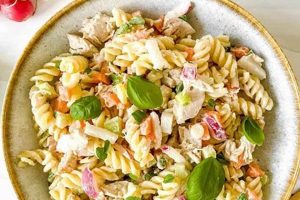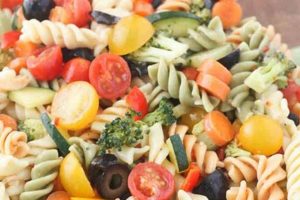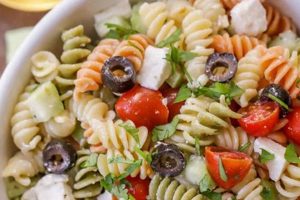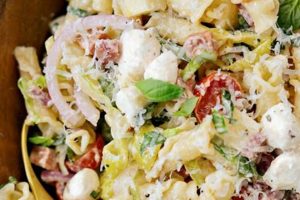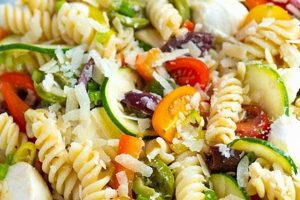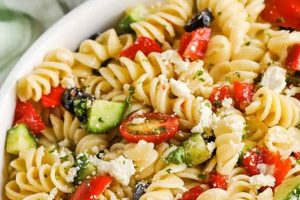Quick and simple pasta salads featuring tortellini offer a convenient and flavorful meal option. These dishes typically combine cooked, refrigerated tortellini (cheese, spinach, or meat-filled) with fresh vegetables, herbs, and a light dressing. An example might include tortellini, cherry tomatoes, chopped cucumber, bell pepper, fresh basil, and a vinaigrette dressing.
The appeal of such recipes lies in their adaptability and ease of preparation. They are ideal for potlucks, picnics, and light lunches or dinners, requiring minimal cooking time and offering a refreshing alternative to heavier pasta dishes. Utilizing pre-made ingredients like refrigerated tortellini significantly reduces preparation time, making them a practical choice for busy individuals. Furthermore, the versatility of these salads allows for customization based on dietary preferences and seasonal ingredient availability.
This article will delve further into variations of these salads, exploring different flavor profiles, ingredient combinations, and dressing options to provide a comprehensive guide for creating delicious and effortless tortellini pasta salads.
Tips for Effortless Tortellini Pasta Salad Creation
Creating a flavorful and convenient tortellini pasta salad involves attention to key elements. The following tips offer guidance for optimal results.
Tip 1: Chill the tortellini after cooking. Rinsing cooked tortellini under cold water and then chilling it prevents sticking and creates a more refreshing salad.
Tip 2: Utilize high-quality ingredients. Fresh, seasonal vegetables and flavorful dressings elevate the overall taste experience.
Tip 3: Consider a variety of textures. Incorporating ingredients like crunchy vegetables, toasted nuts, or crumbled cheese adds textural interest.
Tip 4: Balance flavors. A harmonious blend of savory tortellini, bright vegetables, and a complementary dressing creates a well-rounded flavor profile. Experiment with different vinaigrette styles or consider a creamy pesto-based dressing.
Tip 5: Don’t overdress the salad. Adding the dressing just before serving prevents the salad from becoming soggy. Start with a small amount and add more as needed.
Tip 6: Make it ahead. Tortellini pasta salad can be prepared in advance, making it an ideal dish for gatherings. The flavors often meld and improve after a few hours in the refrigerator.
Tip 7: Add protein for a heartier meal. Grilled chicken, cooked shrimp, or chickpeas can transform the salad into a more substantial meal.
By following these tips, one can create a simple yet satisfying tortellini pasta salad suitable for various occasions. These practical suggestions ensure a successful culinary outcome while minimizing preparation time.
This information provides a foundation for creating personalized tortellini pasta salad recipes tailored to individual preferences. The following section will offer specific recipe ideas and variations.
1. Simple Ingredients
The “easy” in easy tortellini pasta salad recipes hinges significantly on the simplicity of the ingredients. Recipes emphasizing readily available, minimally processed components contribute directly to ease of preparation and reduced cooking time. This accessibility allows for spontaneous meal creation without extensive planning or specialized grocery shopping. For instance, a simple recipe might call for refrigerated tortellini, cherry tomatoes, pre-washed spinach, and a bottled vinaigrette. Such readily available ingredients streamline the cooking process, aligning with the “easy” premise.
Furthermore, the use of simple ingredients often translates to enhanced freshness and flavor. Minimally processed components retain their natural taste and texture, contributing to a brighter, more vibrant salad. Consider the difference between using fresh basil leaves versus a jarred pesto the fresh basil offers a more pronounced, nuanced flavor. This emphasis on fresh, simple ingredients elevates the overall sensory experience while maintaining the ease of preparation. Moreover, it allows for greater flexibility in customizing the recipe to individual preferences. Substituting one simple ingredient for another, such as swapping cherry tomatoes for chopped bell peppers, is straightforward and does not compromise the recipe’s fundamental simplicity.
In summary, the reliance on simple ingredients is crucial for achieving the “easy” aspect of these recipes. It allows for quick preparation, utilizes accessible components, promotes freshness, and provides flexibility for customization. This understanding empowers individuals to create satisfying and flavorful meals efficiently, aligning with the demand for convenient yet delicious culinary solutions. The ability to leverage simple ingredients effectively opens a gateway to exploring a wide range of flavor profiles within the “easy” tortellini pasta salad framework.
2. Quick Preparation
Quick preparation is a defining characteristic of “tortellini pasta salad recipes easy,” directly influencing their appeal and practicality. This attribute hinges on minimizing active cooking time and streamlining assembly, making these salads ideal for time-constrained situations. An examination of the facets contributing to quick preparation reveals the strategic elements that make these recipes efficient and convenient.
- Pre-cooked Ingredients
Utilizing pre-cooked ingredients, particularly refrigerated tortellini, significantly reduces preparation time. Unlike dried pasta requiring boiling, refrigerated tortellini needs only to be heated or, in some cases, can be added directly to the salad. This eliminates a major time-consuming step. Other pre-cooked components, such as rotisserie chicken or canned beans, further contribute to the speed and convenience.
- Simple Procedures
Recipes designed for quick preparation typically involve straightforward procedures. Chopping vegetables, whisking together a dressing, and combining ingredients constitute the majority of the process. Complex techniques, such as making pasta from scratch or creating elaborate sauces, are avoided. This focus on basic culinary skills makes the recipes accessible to a wider range of cooking abilities and experience levels.
- Minimal Cook Time
Beyond the use of pre-cooked ingredients, the overall cook time for these salads is minimized. Quick blanching of certain vegetables or a brief saut of aromatics might be incorporated, but extended cooking periods are avoided. This contributes to the overall efficiency of the recipe, ensuring a meal can be prepared and served quickly.
- Advance Preparation
Many tortellini pasta salads benefit from advance preparation. The flavors often meld and intensify when the salad rests in the refrigerator. Making the salad ahead of time, whether it’s a few hours or the day before, reduces the workload on the day of serving. This makes these salads ideal for potlucks, picnics, or planned meals where time management is crucial.
The convergence of these factors pre-cooked ingredients, simple procedures, minimal cook time, and the possibility of advance preparation distinguishes “tortellini pasta salad recipes easy” as a practical and convenient meal solution. The emphasis on speed and efficiency does not compromise the potential for flavor and variety, as demonstrated by the wide array of ingredient combinations and dressing options available. This balance of ease and deliciousness positions these recipes as a valuable asset for busy individuals and those seeking effortless yet satisfying culinary experiences.
3. Refrigerated Tortellini
Refrigerated tortellini plays a pivotal role in the “easy” aspect of tortellini pasta salad recipes. Its convenience significantly streamlines preparation, making these salads a practical choice for quick meals. An examination of its key facets reveals its impact on recipe efficiency and accessibility.
- Elimination of Cooking Time
Unlike dried tortellini, which requires boiling, refrigerated tortellini is already cooked. This eliminates a significant time investment, allowing for quicker salad assembly. This pre-cooked nature makes it particularly advantageous for time-constrained situations or when access to cooking facilities is limited.
- Immediate Integration
Refrigerated tortellini can often be incorporated directly into the salad after a brief rinse under cold water. This bypasses the need for heating or additional cooking steps, further expediting the preparation process. This ease of integration simplifies recipe execution and contributes to its overall convenience.
- Enhanced Food Safety
The controlled environment of refrigeration mitigates food safety risks associated with storing cooked pasta at room temperature. Refrigerated tortellini maintains its quality and safety, ensuring a readily available and safe-to-consume ingredient.
- Variety of Fillings
Refrigerated tortellini is available with various fillings, such as cheese, spinach, or meat, offering versatility in flavor profiles. This allows for customization and adaptation of recipes based on dietary preferences or desired taste outcomes. The availability of different fillings expands the range of culinary possibilities within the “easy” tortellini pasta salad framework.
The convenience afforded by refrigerated tortellini directly contributes to the simplicity and appeal of “easy” tortellini pasta salad recipes. Its pre-cooked nature, ease of integration, enhanced food safety, and variety of fillings position it as an ideal ingredient for quick, flavorful, and adaptable meals. By eliminating a significant time investment and simplifying the overall process, refrigerated tortellini empowers individuals to create satisfying pasta salads efficiently, aligning with the demand for convenient and delicious culinary solutions.
4. Versatile Dressings
Versatile dressings play a crucial role in the success of easy tortellini pasta salad recipes. The adaptability of these dressings allows for customization and caters to a broader range of flavor preferences, directly contributing to the “easy” aspect by simplifying flavor adjustments. A vinaigrette, for instance, can be easily modified with different vinegars, oils, and herbs, transforming a basic recipe into diverse flavor profiles. Similarly, pesto, a popular choice for tortellini pasta salad, offers variations incorporating different nuts, cheeses, or herbs. This adaptability simplifies recipe adjustments, minimizing the need for complex flavor balancing.
The simplicity of these versatile dressings further aligns with the “easy” theme. A basic vinaigrette requires only oil, vinegar, and seasonings, ingredients typically readily available. Even a homemade pesto can be prepared quickly with a food processor and a few fresh ingredients. This accessibility simplifies ingredient sourcing and minimizes preparation time, enhancing the overall convenience of the recipe. For example, a lemon-herb vinaigrette requires minimal effort yet complements the tortellini and fresh vegetables effectively. Similarly, a sun-dried tomato pesto adds a robust flavor dimension without demanding complex culinary techniques.
The adaptability and simplicity of versatile dressings demonstrate their integral role in easy tortellini pasta salad recipes. They provide a straightforward path to flavor customization while minimizing preparation complexity. This understanding enables the creation of diverse and flavorful salads without compromising the core principle of ease and convenience. The practical application of this knowledge empowers individuals to tailor recipes to specific preferences, enhancing the overall culinary experience while maintaining the efficiency characteristic of “easy” recipes. This flexibility contributes significantly to the enduring popularity of tortellini pasta salad as a convenient and customizable meal option.
5. Adaptable Flavors
Adaptable flavors represent a cornerstone of “tortellini pasta salad recipes easy,” directly contributing to their widespread appeal and practicality. This adaptability stems from the inherent versatility of tortellini, which complements a wide array of ingredients and flavor profiles. The ease with which diverse ingredients can be incorporatedfrom vegetables and proteins to cheeses and herbsmakes customization straightforward, accommodating individual preferences and dietary needs. This inherent flexibility simplifies recipe modification; a vegetarian version, for example, can be achieved by substituting grilled chicken with chickpeas or white beans. Similarly, seasonal variations are readily achieved; asparagus in spring, ripe tomatoes in summer, and butternut squash in autumn can be seamlessly integrated.
The practical significance of adaptable flavors becomes evident when considering real-life scenarios. Imagine a potluck setting where diverse dietary restrictions must be considered. A base tortellini pasta salad recipe can be easily modified to create vegetarian, vegan, or gluten-free versions. Swapping traditional tortellini for gluten-free varieties or incorporating plant-based protein sources showcases this adaptability. Furthermore, adaptable flavors allow for creative use of leftover ingredients. Roasted vegetables, grilled chicken, or even leftover grains can be incorporated, minimizing food waste and maximizing resourcefulness. Consider using leftover grilled salmon and dill in a tortellini pasta salad for a flavorful and resource-efficient meal.
In summary, adaptable flavors are integral to the “easy” nature of tortellini pasta salad recipes. This adaptability facilitates customization, accommodates dietary variations, encourages creative ingredient use, and simplifies recipe modifications. Understanding this interconnectedness empowers individuals to create personalized and satisfying meals efficiently, aligning with the demand for convenient, flavorful, and versatile culinary solutions. This flexibility positions tortellini pasta salad not merely as a simple recipe but as a versatile platform for culinary expression within the constraints of ease and accessibility. The capacity to adapt flavors transforms a basic dish into a personalized culinary experience, contributing significantly to its enduring popularity.
6. Minimal Cooking
Minimal cooking stands as a defining characteristic of “tortellini pasta salad recipes easy,” directly influencing their appeal for time-constrained individuals and those seeking convenient meal solutions. The reduced cooking requirement stems primarily from the use of pre-cooked ingredients, most notably refrigerated tortellini. This eliminates the need for boiling pasta, a significant time investment in traditional pasta dishes. The effect of this minimal cooking approach is a streamlined preparation process, allowing for quick assembly and reduced overall kitchen time. For instance, a simple recipe might involve combining pre-cooked tortellini with chopped raw vegetables, a pre-made dressing, and perhaps a quick saut of aromatics, significantly reducing active cooking time compared to dishes requiring multiple cooking stages and extensive preparation.
The importance of minimal cooking as a component of “tortellini pasta salad recipes easy” extends beyond mere convenience. It contributes to the overall accessibility of these recipes, making them achievable for individuals with varying culinary skill levels. The reduced reliance on complex cooking techniques broadens the appeal of these recipes, empowering even novice cooks to create satisfying meals efficiently. Furthermore, minimal cooking can contribute to preserving the nutritional value of fresh ingredients. Avoiding prolonged heat exposure helps retain vitamins and minerals often lost during extensive cooking processes. This nutritional benefit adds another layer of appeal to these recipes, aligning with health-conscious dietary preferences. Consider a salad featuring fresh spinach, cherry tomatoes, and pre-cooked tortellini; the minimal cooking preserves the vibrant flavors and nutritional value of the fresh produce.
In summary, minimal cooking is intrinsically linked to the “easy” designation of tortellini pasta salad recipes. It streamlines preparation, enhances accessibility, and can contribute to preserving nutritional value. Understanding the practical significance of minimal cooking empowers individuals to create quick, healthy, and flavorful meals efficiently, aligning with the demands of contemporary lifestyles. This focus on simplicity and convenience positions “tortellini pasta salad recipes easy” as a valuable resource for those seeking satisfying culinary experiences without extensive time investments or complex culinary expertise. The ability to leverage minimal cooking effectively expands the possibilities for convenient and nutritious meal options, meeting the needs of diverse individuals and dietary preferences.
Frequently Asked Questions
This section addresses common inquiries regarding easy tortellini pasta salad recipes, providing concise and informative responses.
Question 1: Can dried tortellini be used instead of refrigerated?
Dried tortellini can be substituted, but requires cooking according to package directions before incorporation into the salad. This adds to the overall preparation time.
Question 2: How long can tortellini pasta salad be stored in the refrigerator?
Properly stored in an airtight container, tortellini pasta salad typically lasts for 3-5 days in the refrigerator. Consume within this timeframe for optimal quality and food safety.
Question 3: What are suitable vegetarian protein options for tortellini pasta salad?
Chickpeas, white beans, lentils, or cubed firm tofu offer excellent vegetarian protein sources, complementing the flavors and textures of the salad.
Question 4: Can the dressing be added in advance?
While possible, adding the dressing just before serving is generally recommended. This prevents the salad from becoming soggy and maintains the optimal texture of the ingredients.
Question 5: How can one adapt recipes for gluten-free diets?
Utilize gluten-free tortellini and ensure all other ingredients, including the dressing, are certified gluten-free. Careful ingredient selection is crucial for accommodating gluten-free dietary needs.
Question 6: What are some strategies for preventing the salad from becoming watery?
Ensure all vegetables are thoroughly dried before adding them to the salad. Additionally, salting vegetables like cucumbers and allowing them to drain can reduce excess moisture. Adding the dressing immediately before serving also minimizes the risk of a watery salad.
Understanding these common inquiries facilitates successful preparation and enjoyment of easy tortellini pasta salad recipes. The practical information provided empowers individuals to adapt and customize recipes effectively.
The following section will offer concluding thoughts and recipe suggestions.
Conclusion
This exploration of easy tortellini pasta salad recipes has highlighted the core elements contributing to their convenience and adaptability. The utilization of refrigerated tortellini, coupled with simple ingredients and versatile dressings, minimizes preparation time without compromising flavor. The adaptability of these recipes allows for customization based on dietary preferences, seasonal ingredient availability, and individual tastes. Emphasis on minimal cooking further streamlines the process, making these salads an ideal choice for quick and satisfying meals.
The enduring popularity of tortellini pasta salad underscores its value as a versatile and convenient culinary solution. Exploration of flavor combinations and ingredient variations offers a continuous path toward culinary creativity within the “easy” framework. The simplicity of these recipes does not limit their potential; rather, it provides a foundation for personalized culinary expression, ensuring that tortellini pasta salad remains a refreshing and adaptable dish for diverse occasions and palates.

